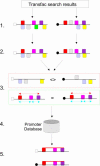PromoterPlot: a graphical display of promoter similarities by pattern recognition
- PMID: 15980503
- PMCID: PMC1160174
- DOI: 10.1093/nar/gki413
PromoterPlot: a graphical display of promoter similarities by pattern recognition
Abstract
PromoterPlot (http://promoterplot.fmi.ch) is a web-based tool for simplifying the display and processing of transcription factor searches using either the commercial or free TransFac distributions. The input sequence is a TransFac search (public version) or FASTA/Affymetrix IDs (local install). It uses an intuitive pattern recognition algorithm for finding similarities between groups of promoters by dividing transcription factor predictions into conserved triplet models. To minimize the number of false-positive models, it can optionally exclude factors that are known to be unexpressed or inactive in the cells being studied based on microarray or proteomic expression data. The program will also estimate the likelihood of finding a pattern by chance based on the frequency observed in a control set of mammalian promoters we obtained from Genomatix. The results are stored as an interactive SVG web page on our server.
Figures


Similar articles
-
CONREAL web server: identification and visualization of conserved transcription factor binding sites.Nucleic Acids Res. 2005 Jul 1;33(Web Server issue):W447-50. doi: 10.1093/nar/gki378. Nucleic Acids Res. 2005. PMID: 15980509 Free PMC article.
-
P-Match: transcription factor binding site search by combining patterns and weight matrices.Nucleic Acids Res. 2005 Jul 1;33(Web Server issue):W432-7. doi: 10.1093/nar/gki441. Nucleic Acids Res. 2005. PMID: 15980505 Free PMC article.
-
FOOTER: a web tool for finding mammalian DNA regulatory regions using phylogenetic footprinting.Nucleic Acids Res. 2005 Jul 1;33(Web Server issue):W442-6. doi: 10.1093/nar/gki420. Nucleic Acids Res. 2005. PMID: 15980508 Free PMC article.
-
Composite Module Analyst: identification of transcription factor binding site combinations using genetic algorithm.Nucleic Acids Res. 2006 Jul 1;34(Web Server issue):W541-5. doi: 10.1093/nar/gkl342. Nucleic Acids Res. 2006. PMID: 16845066 Free PMC article.
-
Promoter analysis.Ernst Schering Res Found Workshop. 2002;(38):65-82. doi: 10.1007/978-3-662-04747-7_4. Ernst Schering Res Found Workshop. 2002. PMID: 12061007 Review. No abstract available.
Cited by
-
ExtraTrain: a database of Extragenic regions and Transcriptional information in prokaryotic organisms.BMC Microbiol. 2006 Mar 15;6:29. doi: 10.1186/1471-2180-6-29. BMC Microbiol. 2006. PMID: 16539733 Free PMC article.
-
Transcription factor site dependencies in human, mouse and rat genomes.BMC Bioinformatics. 2009 Oct 16;10:339. doi: 10.1186/1471-2105-10-339. BMC Bioinformatics. 2009. PMID: 19835596 Free PMC article.
References
-
- Figeys D. Combining different ‘omics’ technologies to map and validate protein–protein interactions in humans. Brief. Funct. Genomic Proteomic. 2004;2:357–365. - PubMed
-
- Werner T. Models for prediction and recognition of eukaryotic promoters. Mamm. Genome. 1999;10:168–175. - PubMed
-
- Werner T. Finding and decrypting of promoters contributes to the elucidation of gene function. In Silico Biol. 2002;2:23. - PubMed
-
- Maruyama K., Sugano S. Oligo-capping: a simple method to replace the cap structure of eukaryotic mRNAs with oligoribonucleotides. Gene. 1994;138:171–174. - PubMed

